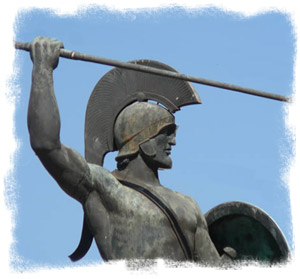
 |
| MAIN |
| Introduction |
| Greek Preparations |
| Armies |
| Battlefield |
| Battle |
| Aftermath |
| Date |
| Monuments |
| COMPLEMENTARY |
| Thermopylae |
| Leonidas I |
| Xerxes I |
| Sparta |
| Thespiae |
| Molon Labe |
| Armies |
||||||||||||||||||||||||||||||||||||||||||
|
Size of the Persian army Xerxes I, king of Persia, had been preparing for years to continue the Greco-Persian Wars started by his father Darius. In 481 BC, after four years of preparation, the Persian army and navy arrived in Asia Minor. A bridge of ships had been made at Abydos. This allowed the land forces to cross the Hellespont. Herodotus of Halicarnassus, who wrote the first history of this war, gave the size of Xerxes's army as follows:
This is the account for the land armies present at Thermopylae. Regarding the total number of forces Xerxes assembed to invade Greece (land army, fleet crew etc), this number needs to be nearly doubled in order to account for support troops and thus Herodotus reports that the total Persian force numbered 5,283,220 men, a figure which is regarded erroneous by modern estimations. The poet Simonides, who was a near-contemporary, talks of four million. Ctesias of Cnidus, Artaxerxes Mnemon's personal physician, wrote a history of Persia according to Persian sources that unfortunately has not survived, and gives 800,000 as the total number of the original army that met in Doriskos, Thrace, after crossing the Hellespont. Modern scholars have given different estimates based on knowledge of the Persian military systems, their logistical capabilities and supplies available along the army's route. Modern estimations tend to consider the
figures given in ancient texts as miscalculations or exaggerations
on the part of the
victors. It is assumed that if Herodotus' 300,000 estimate at
Mycalae were to be accepted, then the land army at Thermopylae
could not have surpassed 500,000, and the total Persian presence
in Greece would be estimated at 1,000,000. This accounts for
one fifth of Herdotus' record. Others give an upper limit of
250,000 total land forces and 500,000 for the expedition. The
main reason most often given for these values is a lack of water;
Sir Frederick Maurice,] a British general in World War I, was
among the first to claim that the army could not have surpassed
175,000 due this reason. A minority of scholars have suggested
land force figures lower than 100,000, while a popular view supports
a range of 100,000-150,000 or 150,000-200,000. The subject has
been hotly debated, but the current consensus rests on the theory
that Herodotus confused Persian terms for chiliarchy and myriarchy
(one thousand and ten thousand). This suggests that the actual
size of the Persian land forces wo The numbers given by Herodotus on the Persian fleet are considered largely realistic. It is generally maintained that Herodotus or his sources had access to official Persian records of the forces involved in the expedition, and it is more likely the numbers on the fleet were given precisely, whereas the contigent of the army may have been listed in general terms rather than exact figures. Whatever the real numbers were, it is clear that Xerxes was anxious to ensure a successful expedition by mustering an overwhelming numerical superiority by land and by sea. Based on the fact that Xerxes led a multi-ethnic army and not just a Persian one, a second school contends that some ancient sources do give realistic numbers. According to the texts the Greeks at the end of the battle of Plataea mustered 110,000 (Herodotus) or 100,000 (Pompeius) troops: 38,700 hoplites and 71,300 or 61,300 peltasts respectively, the difference probably being 10,000 helots. In that battle, according to Herodotus, they faced 300,000 Persians and 50,000 Greek allies. This gives a 6-to-1 ratio for the two armies, which proponents of the school consider a realistic proportion. Furthermore, Munro and Macan argue for realism based on Herodotus giving the names of 6 major commanders and 29 μυρίαρχοι (muriarchoi)—leaders of the baivabaram, the basic unit of the Persian infantry, which numbered about 10,000 strong. As troops were lost through attrition, the Persians preferred to dissolve crippled baivabarams to replenish the ranks of others. It is therefore likely that the units were at full strength. Adding casualties of the battles and attrition due to the need to guard cities and strategic objectives obtains a force of 400,000 minimum. According to this view, there was no lack of water. The available surface water in Greece today satisfies the needs of a much larger population than the number of Xerxes's troops, though the majority of that water is used for irrigation. Other historians' estimates include:
Size of the Greek army According to Herodotus, the Greek army included the following forces:
To this number must be added 1,000 other Lacedemonians mentioned by Diodorus Siculus and perhaps 800 auxiliary troops from other Greek cities, bringing the total up to 7,000. Diodorus gives 4,000 as the total of Greek troops, and Pausanias 11,200. Modern historians, who usually consider Herodotus more reliable, prefer his claim of 7,000 men.
Permission is granted to copy, distribute and/or modify this article under the terms of the GNU Free Documentation License, Version 1.2 or any later version published by the Free Software Foundation.
(What does it mean?)
The text is based on material from the Wikipedia article "Battle of Thermopylae". Modifications, additions to the Wikipedia text and all the photos by the website author. |
||||||||||||||||||||||||||||||||||||||||||
 uld be around 210,000. All
those estimates concern the land forces alone, whereas the entire
Persian presence, including support troops and fleet crew, would
almost double this number, dividing Herodotus' five million figure
by ten.
uld be around 210,000. All
those estimates concern the land forces alone, whereas the entire
Persian presence, including support troops and fleet crew, would
almost double this number, dividing Herodotus' five million figure
by ten.